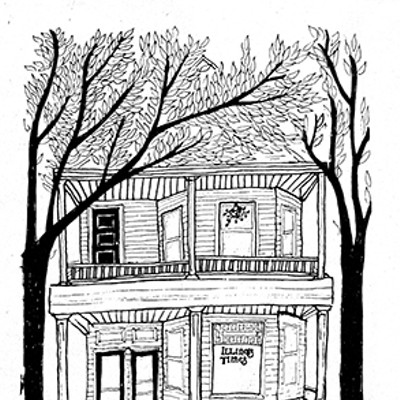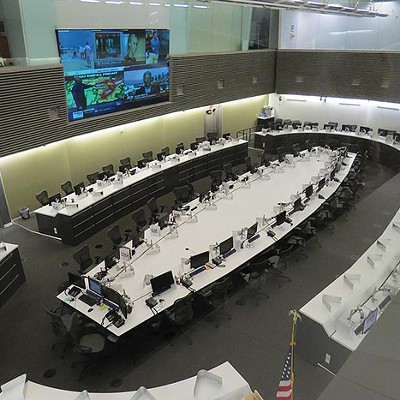The new model museum
Public science in an age of privatized government
[
{
"name": "Air - MedRect Combo - Inline Content 1",
"component": "11490391",
"insertPoint": "3",
"requiredCountToDisplay": "1",
"parentWrapperClass": "fdn-ads-inline-content-block"
},{
"name": "Air - MedRect Combo - Inline Content 2",
"component": "11490392",
"insertPoint": "7",
"requiredCountToDisplay": "5",
"parentWrapperClass": "fdn-ads-inline-content-block"
},{
"name": "Air - MedRect Combo - Inline Content 3",
"component": "11490393",
"insertPoint": "12",
"requiredCountToDisplay": "9",
"parentWrapperClass": "fdn-ads-inline-content-block"
}
]
Bruce Rauner the other day took action that, he explained in a press release, would “develop a sustainable fiscal model for the continued operation of the Illinois State Museum.” I’m a little behind on my reading – Highway Thru Hell reruns – so I thought we had a fiscal model that had sustained the operation of the Illinois State Museum for 138 years. But Mr. Rauner must know more about government than I do, he being a governor and all.
Specifically, Mr. Rauner issued an amendatory veto to SB 317, a bill from Sen. Andy Manar, D-Civilization, intended to reopen the Illinois State Museum and related facilities that were closed to the public last fall. The original bill, he said, “fails to offer any plan to help the museum become self-supporting.” Thanks to the many federal and foundation grants its research work attracts, the museum was more nearly self-supporting than are most operations of state government, but its failure to perfectly support itself can hardly be considered a failure. One expects, say, the coffee shop or gift shop at a public museum to be self-supporting, but the museum itself? Mr. Rauner does. Elsewhere in his message he writes, “despite the good the museum does, its operations are not fiscally sustainable.” Neither are those of a school. Or a church. Or a library. Or a park. It is government’s job, in large part, to fiscally sustain those essential things that the market does not.
From the first, Mr. Rauner’s problem with the museum seemed not to be that the ISM spends the public’s money wastefully, but that it spends such money at all. He seems to see it as a fun attraction, useful to promote the Illinois brand but not essential in the way that, say, motorcycle safety lessons are important. For example, he complained in his veto message, “The State invests more than $6 million per year, despite attendance of only 200,000 visitors per year,” as if the number of people who come to look at the displays is the crucial measure of the institution’s importance.
This misconception is, alas, widespread among the American booboisie. I take the reaction of a reader of Rich Miller’s Capitol Fax blog as representative of the opinion of a goodish chunk of the Illinois public. He or she reminded the people who run it that their museum’s offerings “have to remain relevant” since it is “competing against much more interactive/entertaining content” like that at Abe World. This would be pertinent only if the museum was an entertainment venue. What the museum really is competing against is the steady destruction of potentially valuable archaeological sites, public ignorance and official indifference and other states and universities who would – and now have – poached its staff for talent.
Might Mr. Rauner’s new fiscal model do a better job? His version of the Manar bill would authorize the Department of Natural Resources, the museum’s parent agency, to charge admission fees. No one objects to charging the public a fee to cover at least part of the costs of keeping museum buildings open to the public. But such an innovation looms rather larger in Mr. Rauner’s mind than it seems likely to do in the reopened museum’s budget. He generously allowed that the ticket price might be lowered for, say, schoolkids. Charge ten bucks a head and you’ve taken in a third of the annual cost. But attendance will drop if admission is charged, and reducing the price of tickets for the schoolkids, as he suggests, will further cut the take at the door, since kids are most of the visitors. Anyway, those displays are not the museum’s real work, which is its research and curatorial functions.
In his press release, Mr. Rauner also said he wants the museum to partner with “public and private third parties who are already invested in charitable fundraising and museum operations.” These are ominous words to anyone familiar with the trends in museumology, which have seen august institutions turned into venues for corporate shilling. Wrote our Everyman from Capitol Fax, “Think of a John Deere display on the importance of agriculture in this state.” I have thought of such a thing, and am convinced that what we would get instead is a display of the importance of John Deere to the agriculture of this state.
Mr. Rauner also said the museum should look for partnerships with local governments to share the operation of museum branch sites. Share the operation? Or share the cost of operation? The latter is apt – the museum sites have helped sustain their host communities for years – but the former is pernicious. The only local government’s interest to be thus served is tourism, education’s dropout brother.
I agree utterly with Mr. Rauner that the State of Illinois spends too much money on the wrong things. The hard bit is deciding which are the wrong things. I have little confidence that this governor has a clue.
Contact James Krohe Jr. at [email protected].
Specifically, Mr. Rauner issued an amendatory veto to SB 317, a bill from Sen. Andy Manar, D-Civilization, intended to reopen the Illinois State Museum and related facilities that were closed to the public last fall. The original bill, he said, “fails to offer any plan to help the museum become self-supporting.” Thanks to the many federal and foundation grants its research work attracts, the museum was more nearly self-supporting than are most operations of state government, but its failure to perfectly support itself can hardly be considered a failure. One expects, say, the coffee shop or gift shop at a public museum to be self-supporting, but the museum itself? Mr. Rauner does. Elsewhere in his message he writes, “despite the good the museum does, its operations are not fiscally sustainable.” Neither are those of a school. Or a church. Or a library. Or a park. It is government’s job, in large part, to fiscally sustain those essential things that the market does not.
From the first, Mr. Rauner’s problem with the museum seemed not to be that the ISM spends the public’s money wastefully, but that it spends such money at all. He seems to see it as a fun attraction, useful to promote the Illinois brand but not essential in the way that, say, motorcycle safety lessons are important. For example, he complained in his veto message, “The State invests more than $6 million per year, despite attendance of only 200,000 visitors per year,” as if the number of people who come to look at the displays is the crucial measure of the institution’s importance.
This misconception is, alas, widespread among the American booboisie. I take the reaction of a reader of Rich Miller’s Capitol Fax blog as representative of the opinion of a goodish chunk of the Illinois public. He or she reminded the people who run it that their museum’s offerings “have to remain relevant” since it is “competing against much more interactive/entertaining content” like that at Abe World. This would be pertinent only if the museum was an entertainment venue. What the museum really is competing against is the steady destruction of potentially valuable archaeological sites, public ignorance and official indifference and other states and universities who would – and now have – poached its staff for talent.
Might Mr. Rauner’s new fiscal model do a better job? His version of the Manar bill would authorize the Department of Natural Resources, the museum’s parent agency, to charge admission fees. No one objects to charging the public a fee to cover at least part of the costs of keeping museum buildings open to the public. But such an innovation looms rather larger in Mr. Rauner’s mind than it seems likely to do in the reopened museum’s budget. He generously allowed that the ticket price might be lowered for, say, schoolkids. Charge ten bucks a head and you’ve taken in a third of the annual cost. But attendance will drop if admission is charged, and reducing the price of tickets for the schoolkids, as he suggests, will further cut the take at the door, since kids are most of the visitors. Anyway, those displays are not the museum’s real work, which is its research and curatorial functions.
In his press release, Mr. Rauner also said he wants the museum to partner with “public and private third parties who are already invested in charitable fundraising and museum operations.” These are ominous words to anyone familiar with the trends in museumology, which have seen august institutions turned into venues for corporate shilling. Wrote our Everyman from Capitol Fax, “Think of a John Deere display on the importance of agriculture in this state.” I have thought of such a thing, and am convinced that what we would get instead is a display of the importance of John Deere to the agriculture of this state.
Mr. Rauner also said the museum should look for partnerships with local governments to share the operation of museum branch sites. Share the operation? Or share the cost of operation? The latter is apt – the museum sites have helped sustain their host communities for years – but the former is pernicious. The only local government’s interest to be thus served is tourism, education’s dropout brother.
I agree utterly with Mr. Rauner that the State of Illinois spends too much money on the wrong things. The hard bit is deciding which are the wrong things. I have little confidence that this governor has a clue.
Contact James Krohe Jr. at [email protected].
Illinois Times has provided readers with independent journalism for almost 50 years, from news and politics to arts and culture.
Your support will help cover the costs of editorial content published each week. Without local news organizations, we would be less informed about the issues that affect our community..
Got something to say?
Send a letter to the editor and we'll publish your feedback in print!





















